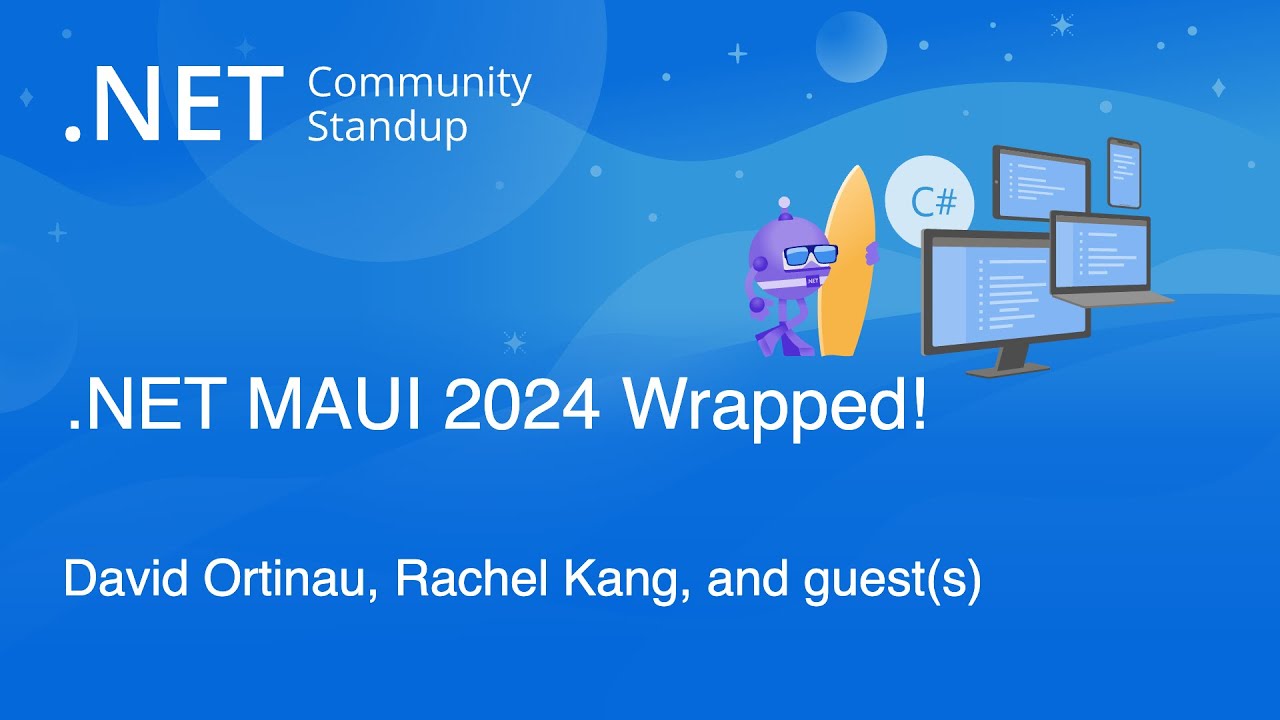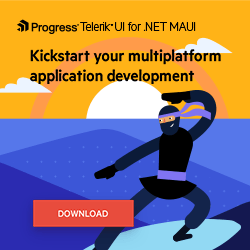Sands of MAUI: Issue #168

Welcome to the Sands of MAUI—newsletter-style issues dedicated to bringing together the latest .NET MAUI content relevant to developers.
A particle of sand—tiny and innocuous. But put a lot of sand particles together and we have something big—a force to reckon with. It is the smallest grains of sand that often add up to form massive beaches, dunes and deserts.
.NET developers are excited with the reality of .NET Multi-platform App UI (.NET MAUI)—the evolution of modern .NET cross-platform developer technology stack. With stable tooling and a rich ecosystem, .NET MAUI empowers developers to build native cross-platform apps for mobile/desktop from single shared codebase, while inviting web technologies in the mix.
While it may take a long flight to reach the sands of MAUI island, developer excitement around .NET MAUI is quite palpable with all the created content. Like the grains of sand, every piece of news/article/documentation/video/tutorial/livestream contributes toward developer experiences in .NET MAUI and we grow a community/ecosystem willing to learn and help.
Sands of MAUI is a humble attempt to collect all the .NET MAUI awesomeness in one place. Here’s what is noteworthy for the week of December 9, 2024:
.NET MAUI Wrapped
The .NET MAUI team hosts monthly Community Standup livestreams to celebrate all things .NET MAUI and provide updates—a wonderful way to bring the developer community together. A lot of good things are happening for .NET MAUI developers, and developer community excitement is noticeable. David Ortinau and Rachel Kang hosted the last .NET MAUI Community Standup of the year—.NET MAUI 2024 wrapped.
It was good to see folks from the extended .NET MAUI team join the Community Standup as guests—the likes of Maddy, Jon, Shane and Matt. After some usual banter and community updates, the team got down to recapping 2024 for .NET MAUI—it has been an impactful year. Between GA, Preview and Service releases, the team shipped 32 total .NET MAUI releases in 2024—a busy and productive year for sure. The cherry on top is the .NET MAUI release for .NET 9—this was a huge GA release and developers have a lot to catch up on from the recent .NET Conf 2024.
No developer platform survives without community involvement. The .NET MAUI team pointed out many of the impactful content pieces and the huge number of open-source code contributions from the community. Congratulations on an awesome year, .NET MAUI—the platform and the developer community grows together.

TemplatedButton with .NET MAUI
.NET MAUI is the evolution of modern .NET cross-platform development stack, allowing developers to reach mobile and desktop form factors from a single shared codebase. Modern .NET cross-platform apps are inherently complicated, and developers could use some UI tooling toward increased productivity—Telerik UI for .NET MAUI can help. Even things as simple as buttons can invite lots of customizations for UI/behavior, and Héctor Pérez wrote up an excellent article—exploring the Telerik .NET MAUI TemplatedButton.
Progress Telerik UI for .NET MAUI can help developers building modern .NET cross-platform apps—professionally engineered UI components shine with consistent rendering, fine-tuned performance and dependability with documentation/support. Héctor starts with the basics—developers can get started quite easily with Telerik UI for .NET MAUI, and rendering the simple TemplatedButton UI control is a breeze.
However, the real benefits are apparent when developers need to customize the styling of the rendered TemplatedButton. Custom properties like Background, BackgroundColor, BorderBrush, BorderColor, BorderThickness, CornerRadius and more showcase the Telerik button’s flexibility. Developers have a variety of ways to configure the content of the TemplatedButton—simple strings ranging to full-on ContentTemplates provide flexibility for developers.
For .NET MAUI developers, it is also important to be able to wire up the TemplatedButton with Event/Commands support and be able to easily work with defined Visual States. The Telerik TemplatedButton is happy to oblige. Kudos to Héctor for writing up a detailed article showing code examples and showcasing the flexibility of the Telerik TemplatedButton—developer productivity for the win.

Unit Testing in .NET MAUI
.NET MAUI is built to enable .NET developers to create cross-platform apps for Android, iOS macOS and Windows, with deep native integrations, platform-native UI and hybrid experiences. Unless you write absolutely perfect code or test in production, the key to developer sanity while building modern .NET cross-platform apps is unit testing. It is a bit of art to isolate and test small specific parts of code, and Leomaris Reyes wrote up a wonderful article—unit testing in .NET MAUI.
Leomaris begins with the basics of unit testing toward isolating small pieces of code individually to verify functionality. The benefits are early error detection and improved code quality. The discussion then dives into xUnit—the widely used unit testing framework for writing and running automated tests for .NET applications.
Leomaris walks through how to add xUnit tests to .NET MAUI projects—there are some important configuration steps for seamless testability. Unit tests are often written as facts or theories and exude in the popular Arrange-Act-Assert pattern. Leomaris showcases how to write and run unit tests for .NET MAUI projects, along with some common pointers for success. Modern cross-platform development is tricky enough—a solid unit testing strategy increases code coverage and contributes toward developer confidence and sanity.

Progress Telerik Release
Modern mobile/desktop clients or web frontends are complicated, and developers can use all the help available to stay productive. Progress Software maintains a suite of UI components and libraries/tools to help developers be more successful—Telerik UI for all things .NET, and Kendo UI for all things JavaScript. There are fresh new bits to help .NET developers be more successful—say hello to the Telerik/Kendo UI 2024 Q4 release.
The latest release breaks new ground in UI development with professionally built design system assets, advanced data-driven visualizations and Day-Zero support for the latest .NET and JavaScript frameworks—with built-in support for .NET 9, Angular 19 and React 19. The Telerik journey with .NET 9 started with early preview releases—not just making sure product updates were compatible with latest .NET 9, but leveraging platform features to squeeze out every bit of performance from .NET.
The Telerik release packs a lot of new enterprise-ready UI components with support for the latest runtimes—across ASP.NET Core, Blazor, .NET MAUI, WinUI, WPF, WinForms and more. The Telerik UI for .NET MAUI suite earns a whole bunch of fresh new UI components, with DatePager and GridSplitter controls leading the way and a brand new preview Theming mechanism. Developers should have much to celebrate in the big release with hot new bits for developer productivity across .NET/JS—upwards and onwards.

RAG Explained
It is the age of artificial intelligence. AI is slowly changing the way we live and work, and AI’s popularity is driving adoption in enterprise and consumer apps. AI presents a huge opportunity for .NET developers to infuse apps with solutions powered by generative AI and large language models (LLMs), as well as boost developer productivity. However, despite the enormous potential, modern AI has some potential pitfalls that developers will do well to understand, and Peter Vogel wrote up a piece to explain some concepts—fixing LLMs with RAG.
Modern AI large language models (LLMs) are quite the tech-tonic shift in how general purpose they are and amount of computing they operate on at scale/diminishing cost. However, AI models for all their smartness are often plagued by notorious hallucinations. LLMs are powered by huge corpus of information which have latency and responses are based on pattern matching instead of actual knowledge.
AI can be surprisingly human—instead of admitting ignorance, it will happily guess and make up things that match. At the moment, retrieval augmented generation (RAG) seems to be a potential solution. Using RAG, LLM responses can be grounded with topical and timely trusted information with citations—this is meant to provide reliability within a given context. For enterprises and developers implementing AI solutions, RAG presents a way to increase reliability with deeply contextual trusted sources of information guiding the AI Model’s responses. Hallucination-free AI can empower more critical workflows and increase responsible adoption.

That’s it for now.
We’ll see you next week with more awesome content relevant to .NET MAUI.
Cheers, developers!

Sam Basu
Sam Basu is a technologist, author, speaker, Microsoft MVP and gadget lover. With a long developer background, he also worked as a Developer Advocacy Manager for advocating modern web/mobile/cloud development platforms on Microsoft/Telerik/Kendo UI technology stacks. His spare times call for travel, fast cars, cricket and culinary adventures with the family.

